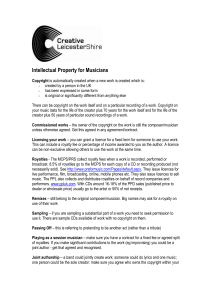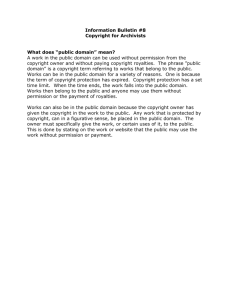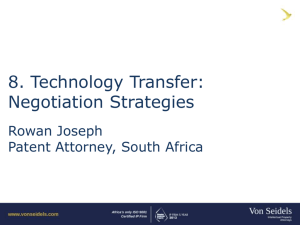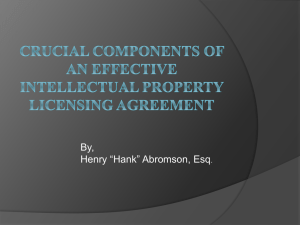International Income Taxation Chapter 12: E I
advertisement
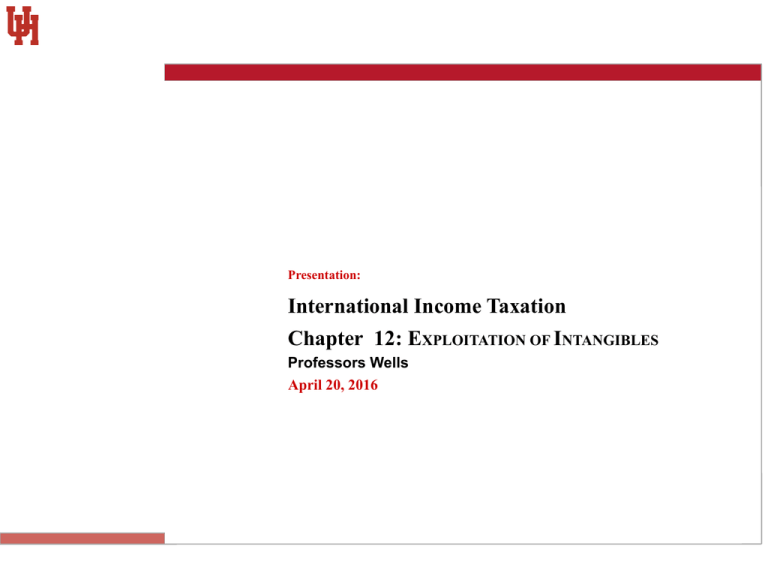
Presentation: International Income Taxation Chapter 12: EXPLOITATION OF INTANGIBLES Professors Wells April 20, 2016 Chapter 12 – Exploiting Intangibles Outside U.S. Choices for structuring these arrangements: 1) Independent licensing for royalties. 2) Transfer of intangible property rights in independent capital gains transaction. 3) Transfer of intangibles to foreign corporation in Code §§351/367 transaction. 4) Cost sharing arrangements. 5) Use of foreign base company for licensing. 2 Definition of Intangibles p. 967 1) Patents, inventions, know-how. 2) Copyrights. 3) Trademarks, tradenames. 4) Franchises, licenses, contracts 5) Methods, programs, systems, customer lists, etc. 6) Other similar items. Reg. §1.482-4(b) (& Code §936(h)(3)(B)) 3 Licensing Intangibles to an Independent for Royalties International licensing enables royalties without a significant foreign investment. Limited foreign country tax on royalty. Use royalties from unrelated licensees in licensing trade or business to enhance amount in the general limitation FTC basket. Code §904(d)(1)(B) & §954(c)(2)(A) (i.e., royalties not in the passive income basket). 4 Licensing Intangibles to an Affiliate for Royalties Use no/low taxed royalties in foreign country to average down the foreign tax cost for purposes of the overall FTC limitation. Royalties as an income tax deduction to the payor in the payor’s country? This assumes the royalties will enable classification within general limitation FTC basket (under look-through rules). 5 Tax Treatment of Royalties in Source Country p. 969 Royalty payments are deductible in the licensee/payor’s country (?). Transfer pricing considerations in the payor’s country under (i) payor country’s tax law, or (ii) an applicable bilateral tax treaty. Licensor’s tax treatment in source country? 1) Treaty – exemption or low withholding rate. 2) Domestic tax rules – withholding at source. 6 U.S. Tax Treatment of Royalty Income p. 970 For foreign tax credit purposes, consider the following: 1. Unrelated party royalties: are the royalties received from unrelated parties received in the active conduct of the licensor’s trade or business? If so, then FTC general limitation income: §904(d)(1)(B) & 954(c)(2)(A). 2. Related Party Royalties: are the royalties reducing passive basket income of the related party payor? If not, then the royalty is general basket income pursuant to the look-through rules of §904(d)(3)(A) and (C). Otherwise, §904(d)(1)(A) passive basket. Necessity for exploiting inventions generated through own research and development – to qualify for the active-business test. 7 Problem U.S. Pharma Patents p. 972 Comet regularly buys U.S. and foreign pharmaceutical patents. Technical employees responsible for commercialization of patents. Licensing in the United States and abroad in return for royalties equal to a specified percentage of the net sales by the licensees. Source of royalties? U.S./foreign patents? What FTC limitation basket? A or Residual B (after 2006) basket? 8 Capital Gains Licensing p. 973 Transfer of all substantial rights as constituting a sales of: (1) a capital asset or (2) a §1231 property and eligibility for LTCG treatment (assumed to be important, i.e., not a corporate licensor). Treatment under §§1221, 1231 and 1235 (not treatment as only ordinary income received). 9 Patents & Trademarks & Goodwill p. 973 Patents as (1) capital or (2) §1231 assets. §1235 – deemed sale or exchange treatment – only applicable to individuals. Patent as a monopoly grant – 20 years from date of application. A federal property law concept. Possible authorization of tax basis by purchaser. 10 Know-how p. 974 Know-how as secret information – the right to prevent unauthorized disclosure; a local law property concept. Can it be a capital asset for capital gains licensing purposes? Rev. Rul. 64-56 – foreign country where the transferee is located must provide substantial legal protections against the unauthorized disclosure of the know-how. 11 Copyrights p. 976 Monopoly granted under federal law for 70+ years in the U.S. A foreign law comparable? No capital gains treatment if personal efforts of the holder created the copyrighted work. §§1221(a)(3)(A) and 1231(b)(1)(C). See Reg. §1.861-18 concerning transfers of computer programs. Copyright sale necessitates transfer of all substantial rights. 12 Patent “Sale” Requirement p. 977 What is a sale or exchange of a patent? 1) Actual assignment (i.e., title transfer). 2) Exclusive license to use, manufacture and sell the patented invention within a defined geographical area for the remaining life of the patent. Retention of legal title to the patent. Assignment of all substantial rights to the patent can be treated as sale for tax purposes. 13 “Sale” Requirement, Continued Forms of Payment p. 978 Possible payment options enabling LTCG treatment: 1) Single fixed payment 2) Fixed installment payments 3) Contingent payments over specified period (useful life of the asset?) Payment for ancillary services permitted. 14 Retained Patent Rights (Sale Treatment Permitted) “Snap-back” provisions can be retained (where not within the transferor’s control): 1) 2) 3) 4) 5) Bankruptcy; Lack of productivity and, therefore, inadequate royalties; Exportation of the property; Exchange controls become applicable; Veto right over sublicensing. Cf., right to sublicense in licensee’s territory. 15 DuPont Case Income Characterization p. 980 Functional subdivision of foreign patent rights funds received in exchange for assignment of certain Brazilian patents taxable as ordinary income or capital gains? Refund claim based on capital gains status, after reporting as ordinary income. §1222 and §1231? Conclusion: division of functional applications is acceptable to enable sale treatment. 16 Problem Independent Licensee p. 985 1) Exclusive license to independent licensee. License otherwise qualifies as a sale. Right to terminate: a) After license is in effect for ten years; Not a transfer of all substantial rights, since not for the 20 year life of the patent. b) Exchange controls – beyond the control of the licensor – not vitiating sale treatment. Continued 17 Problem, Continued p. 986 c) Bankruptcy of the licensee – same as b. d) Failure to reach production levels. If production levels are reasonably attainable, then not within the control of the licensor and this condition is not inconsistent with a sale. e) Failure to use “best efforts” to develop market. Best efforts as a subjective standard, but the licensor’s judgment on this issue would not be determinative. Continued 18 Problem, Continued p. 986 f) Quality standards. Consistent with sale status if the quality standards are appropriate and reasonably attainable. g) Failure to supply reasonable needs of the customers. Not preventing qualification of the license as a sale. h) Right to veto sublicensing. Veto over sublicensing is not inconsistent with a sale. 2. Non-exclusive license? 19 Sales of Know-How and Trade Secrets p. 991 Value of know-how is dependent upon continuing secrecy and not a govt. monopoly. DuPont Case, p. 986 No “sale” here” IRS says secret process was property but that no “sale” occurred and, therefore, no preferential capital gains treatment. Transfer of a trade secret may be equivalent to a sale. Must transfer the right to prevent unauthorized disclosure of the secret. 20 Sales of Copyrights as Business Profits? p. 993 A copyright can be sold – including for royalty payments (rather than for a lump sum). Computer programs – many formats for the transfer of rights (Reg. §1861-18): 1) 2) 3) 4) Copyright transfer Transfer of a copy of a computer program Services for program use Know-how concerning programming 21 Sale of Patent Rights to a Foreign Controlled Corp. p. 995 §1249 – Gain realized on a patent, etc., transfer to a foreign corporation controlled by the transferor – will be treated as ordinary income and not as capital gain. §1249(b) – Control means ownership, directly, indirectly or constructively, of the stock of the foreign corporation possessing more than 50 percent of the total combined voting power of all voting classes of stock. 22 Transfers of Trademarks, Tradenames & Franchises §1253 p. 996 Ordinary income and not capital gains if the transferor retains any significant power, right or continuing interest with respect to the transferred property. See §1253(b)(2) relisting of what constitutes a “significant power, right or continuing interest”. 23 Syncsort v. U.S. Franchise License Are computer software licenses to foreign licensees within the scope of §1253? Yes. Are related intangibles treated as transfers separate from franchise transfer? NO. Holding: Rights transferred represented “franchises” within the meaning of §1253(a) to which “substantial rights” were retained. Ordinary income was realized. p. 998 Exclusive License for Certain Foreign Countries 1. §1253(a) defines franchise to include “right to distribute / sell” 2. Substantial Rights per §1253(b) A. Right to disapprove assignment -§1253(b)(2)(A) B. Right to control quality standards -§1253(b)(2)(C) C. Sole Distributor -§1253(b)(2)(D) D. License fee contingent on use/disposition -§1253(b)(2)(F) Pandata NV Shell Australia Syncsort (US) Computer Benefits Ltd. Software Engineering Co. Ltd. 24 OID Issue – Sale for Stated Amount/No Interest Installment payments for intangible sales. OID may be imputed - §1274 applies if the stated redemption price exceeds imputed principal amount. When does this occur? p. 1005 Assume AFR is 5% $100,000 $100,000 $100,000 $100,000 $354,595* * Sales price is $354,595, not $400,000 Excess $45,405 is interest for all tax purposes §1275 is inapplicable for less than $250,000 sales; but §483 is then applicable and the result is essentially similar §1235(a) (individual) sales or exchanges are not subject to §1274 or §483 rules. 25 Source of Income Rules & Intangible Property To the residence – where a fixed price sale. §865(a) and (d)(1)(A). Including deferred. Royalty source rule if the price is contingent on productivity. §862(a)(4). §865(d)(4)(B). Special sourcing rule for goodwill – source to the country in which the goodwill was generated. §865(d)(3). p. 1006 International Multifoods v. Commissioner $2.5 million International Multifoods Buyer Mister Donuts (Asia) Holding: Goodwill was not separate from franchise and sourced under general rule of §865(a). §865(d)(3) sourcing rule only applies to goodwill that is independent of franchise and trademarks. How can goodwill be sold independent of these intangibles? 26 Transfer of Intangibles in Exchange for Stock p. 1010 1) Cost basis of intangible property transferred is probably zero – since §174 permits a current R&D deduction. 2) If §351 does not apply because not a transfer of property, then it is a license for stock and stock is immediate income recognition (prepaid royalty). Thereafter, §482 may apply to review that the prepaid royalty was in an amount sufficient to satisfy the “commensurate with income” standard. 3) If §351 applies, then §351 precludes gain recognition on the transfer of appreciated assets, if applicable: - must transfer “property” - transferors must have 80% control (as a group) in the transferee corporation. 27 §367(d) Rules for Intangible Property Transfers p. 1012 4. §367 Issues. When §351 applies to prevent immediate gain recognition on transfer of intangible for stock, the application of §351 calls into application §367(d) which provides as follows: a) No immediate income tax recognition. b) But licensing treatment, as if sold to transferee for periodic payments. c) Full gain recognition if sold by the foreign corporation after transfer to the foreign corporation (of if the corp. stock sold). d) Treated as ordinary income e) Until TRA-97, the deemed royalty was also treated as U.S. source income. Now, it is treated as foreign source. f) Exception for foreign goodwill or going concern value. g) Valuation problems – super-royalty provision, i.e., amount treated as received must be “commensurate with income”. h) Foreign corp. E&P reduction - §367(d)(2)(B). 28 §367, Continued p. 1014 Other §367(d) considerations: - Use a sale/license rather than §351 transfer? - Royalty is treated as an account receivable under §367(d). - Elect sale treatment? U.S. source ordinary income; Reg. §1.367(d)-1T(g)(2). - Transfer to a partnership – see §367(d)(3) (Note partnership tax rule in Subchap. C). 29 “Property” Requirement – A Code §351 Element p. 1017 Rev. Rul. 64-56 (p. 920) – does “know-how” constitute “property” for §351? Or services? To be “know-how” the country where the transferee operates must afford the transferor substantial legal protection against the unauthorized disclosure and use of the process, formula, or other secret information involved. See Rev. Proc. 69-19, p. 1021. If transferor agrees to perform services attendant with the know-how transfer: 1. Transfer is entirely a property transfer if services are “ancillary,” but 2. Transfer is part property transfer and part service arrangement if services are not “ancillary.” Impact: Payment of stock for services is immediately taxable as service income. 30 Transfer Requirement of §351: “All Substantial Rights” p. 1022 Transfer must be made of “all substantial rights” for a property transfer to occur for §351 purposes. Ordinarily, the transfer of economic rights for intangibles is accomplished by an exclusive license, rather than by a legal assignment. Retention of certain controls and rights of recapture may be acceptable for this purpose. 31 DuPont Case Non-Exclusive License Royalty-free non-exclusive license to sub to make, use and sell herbicide in France. p. 1023 Non-exclusive, royalty license gave licensee: 1. Right to sell, use, make herbicide 2. Right to sub-license for manufacturing needs but otherwise need need consent. E.I. Du Pont de Holding: Transfer of non-exclusive Nemours (US) license was held to be a completed transfer for §351. A transfer of property Stock Du Pont de Nemours in exchange for stock for §351 is a (France) SA different standard than the standard for capital gain treatment that requires a sale or exchange of “all substantial rights” for §1235 (“all substantial rights”), §1249 (looks to §1235, and §1253 (no retained “significant right”). Reason for Difference: capital gains provisions contemplate a completeness of disposition whereas §351 is based on control over the transferred rights. 32 Transfer as a “Contribution to Capital” p. 1029 §367(c)(2) – contribution to corporation treated as a constructive exchange for §367 purposes. If the transfer is made of an appreciated “intangible” – then subject to the further provisions of §367(d). 33 Base Company Licensing & Headquarters Entity Possible to get larger afterforeign tax profits in an offshore licensing company (when compared to payments directly into the United States). Royalty paid permitted as a deduction for foreign country payor tax purposes Generate low/no taxed royalty income to blend with high taxed income. p. 1030 Review Question: How do we avoid FPHCI characterization? High-Tax Low-Tax Royalty High-Tax AmCo (US) Intermediate Holdco (Netherlands) High-Tax OpCo (Germany) 34 Applicability of Subpart F Rules – Deferral Available? p. 1033 Royalties are not subject to Subpart F if: i) Related party/same country exception is available. §954(c)(3)(A), or ii) “Active conduct of a trade or business” exception of §954(c)(2)(A) is not available for related party royalties. iii) Royalty payment from disregarded entity is a “non-event” for subpart F purposes. iv) §954(c)(6) exclusion for CFC-to-CFC royalties has expired. Will it be extended as part of tax reform? v) Review Question: How do we avoid FPHCI characterization? High-Tax Low-Tax Royalty High-Tax AmCo (US) Intermediate Holdco (Netherlands) High-Tax OpCo (Germany) De minimis exception of §954(b)(3)(A) vi) High tax exception of §954(b)(4) will not apply. 35 Foreign Tax Credit Limitation Impact p. 1033 General Basket Income under §904(d)(1)(A) if: 1. The royalty income is excluded from the definition of foreign personal holding company income of §954(c) due to the “active conduct of a trade or business” exception in §954(c)(2)(A), or 2. Royalties are §954(c) income but they are paid by a related CFC and are placed in the general basket income by reason of the look-through rules of §904(d)(3). 36 Seaborn Problem p. 1037 Part A. Part B. Sub-Licensing High-Tax 1. Non-exclusive license for royalty Seaborne, Inc. (US) subject to §482. Seaborne, Inc. (US) High-Tax Seaborne Licensing (Switzerland High-Tax Seaborne S.A. (Germany) Seaborne (France) SA 2. License for shares. Is this a §351 transfer? If so, then §367(d) applies. If not, then §482 applies. High-Tax Seaborne, Inc. (US) Seaborne, Inc. (US) High-Tax Stock Seaborne Licensing (Switzerland Seaborne (France) SA Unrelated 37 Arm’s Length Pricing Requirement p. 1038 Arm’s length pricing concepts for transfers of intangibles apply to: 1) License, 2) Sale, and 3) Contribution to transferee’s capital (with or without stock being received in the exchange). 38 Alternative Arm’s Length Pricing Approaches p. 1042 Treas. Reg. §1.482-4(a). 1) Comparable uncontrolled transaction (CUT) 2) Comparable profit method (CPM) 3) Profit split method (PSM) Subject to applicability of the “best method” approach. Reg. §1.482-1(c). Alternative: Possible cost-sharing agreement. 39 Pharma Problem p. 1049 Drug B license with an independent as a comparable uncontrolled transaction (CUT) for the controlled licenses of drugs A and C? Relevant criteria: 1) Patented? 2) Represent significant reach high sales levels 3) Anticipated same average annual profits. 4) Should C be adjusted upward for extra cost of clinical trials? Drug B: 12% Royalty %R A : 12 oyalty Pharma Inc. (US) Worlddrug SA % C: 14 y lt Roya Pharma Int’l SA 40 Cost Sharing Arrangements Reg. §1.482-7 p. 1050 Sharing of costs and risks for developing intangible property in return for a property interest in that intangible. Must have a method to calculate each controlled participant’s share of the intangible development costs – based on anticipated benefits to be received. 41 Buy-In and Buy-Out Arrangements p. 1061 Treas. Reg. §1.482-7(g). Compensation must be provided for the contributor of any excess value. Cost Sharing Arrangement among Affiliates Pre-Existing IP Astra (US) FS #1 Buy- in Pa ymen t FS #2 42 Astra Problem p. 1061 Qualified Cost Sharing Agreement but actual benefits deviate by more than 20% from the projected benefits. Question: Can the IRS make a transfer pricing adjustment? Cost Sharing Arrangement among Affiliates ü ü Estimate: 45% Actual: 50% Estimate: 35% Actual: 20% FS #1 Astra (US) 36% < 50% < 56.25% FS #2 Estimate: 20% Actual: 30% 40% < 50% < 62.5% 43
